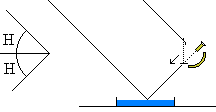Artificial Horizon
In a location away from the sea where the horizon is not immediately visible,
it is not possible to take Altitudes of celestial bodies with
the Sextant in the usual way.
One way to work around this problem is to use an artificial horizon.
The artificial horizon can be made with a plate, filled with some liquid.
Water will do, but oil is better.
A pool can also be used, if there is no wind or waves
(the water surface must be completely flat).
The purpose of the liquid is to obtain an ideal horizontal
(reflecting) surface.
 |
|
To take the Altitude with the artificial horizon,
the sextant must be pointed towards the reflected image (instead of the horizon)
and the reflected image of the celestial body must be made to
coincide with the direct image.
The angle read from the sextant this way, is twice the Altitude
of the body. This is illustrated on the left.
One of the limitations of this method is that it is not possible
to take altitudes of bodies with Altitudes larger than 60°
or so, because sextants can not measure angles larger than 120°.
|
The following must be considered for determining the Observed Altitude (Ho)
from measurements with the artificial horizon as described above:
- The index error as well as the sextant reading must be divided by two.
- The Dip Correction and Semi-Diameter Correction must be set to zero.
|
